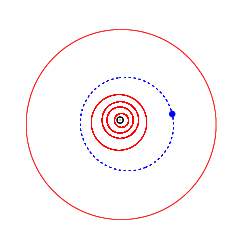Discovered by T. HiokiN. Kawasato MPC designation (9942) 1989 TM1 Minor planet category main-belt · (middle) Discovered 8 October 1989 Discovery site Okutama observatory | Discovery date 8 October 1989 Alternative names 1989 TM1 Observation arc 26.64 yr (9,732 days) Orbits Sun Asteroid group Asteroid belt | |
 | ||
People also search for Sun, (25285) 1998 WB7, (5339) 1992 CD | ||
(9942) 1989 TM1 is a stony asteroid from the middle region of the asteroid belt, approximately 4.5 kilometers in diameter. It was discovered on 8 October 1989, by Japanese astronomers Nobuhiro Kawasato and Tsutomu Hioki at Okutama Observatory (), Japan.
The stony S-type asteroid orbits the Sun at a distance of 2.2–3.0 AU once every 4 years and 2 months (1,528 days). Its orbit has an eccentricity of 0.17 and an inclination of 10° with respect to the ecliptic. A precovery was taken at the U.S. Palomar Observatory on 30 September 1989, extending the asteroid's observation arc by just 9 days prior to its official discovery observation.
In October 2010, a rotational light-curve for this asteroid was obtained from photometric observations at the U.S. Palomar Transient Factory, California. It rendered a tentative rotation period of 7000307060000000000♠3.0706±0.0004 hours with a brightness variation of 0.08 in magnitude (U=1).
The asteroid was predicted to cross the focal plane array of the Infrared Astronomical Satellite (IRAS). However, it was missed on each of its seven planned observation and was never detected. According to the "missed predictions file" of the supplemental IRAS minor planet survey (SIMPS), the body was expected to have a diameter of 13.5 kilometers and an absolute magnitude of 13.20. Based on an absolute magnitude of 13.99, and an assumed standard albedo for stony asteroids of 0.20, the Collaborative Asteroid Lightcurve Link calculated a much smaller diameter of 4.7 kilometers, which agrees with a diameter of 4.1 kilometers, found by NASA's Wide-field Infrared Survey Explorer with its subsequent NEOWISE mission.
